Although Hanoi is Vietnam’s capital city, its largest city is Ho Chi Minh City. Also known as Saigon, this city has played an important role in Vietnam’s history and is now a major hub for finance, technology, media and more.
Many people advised us against spending any time in Ho Chi Minh City in favor of more time in Hanoi or Hoi An and surrounding areas. But I wanted to see Vietnam’s biggest city. I tend to enjoy big cities people say are not worth seeing (like Athens).
While I do think Ho Chi Minh City is worth visiting, I can understand why tourists might prefer Hanoi. Ho Chi Minh City looks and feels like a big city. The tall buildings make the city feel very modern. We also witnessed more people wearing western styles, sporting tattoos, etc. Hanoi, on the other hand, is smaller and feels more historical. There are also day trips around Hanoi that immerse you in a ton of natural beauty from the mountains to the sea.
If you have under two weeks, I’d probably recommend sticking to Hanoi and and surrounding areas. However, if you have two weeks or longer, I think Ho Chi Minh City is worth seeing. The contrast in culture between the regions within the same country is worth experiencing on its own.
But what is there to do in Ho Chi Minh City? These are 14 amazing things I did in three days in Vietnam’s biggest city.
Visit the War Remnants Museum
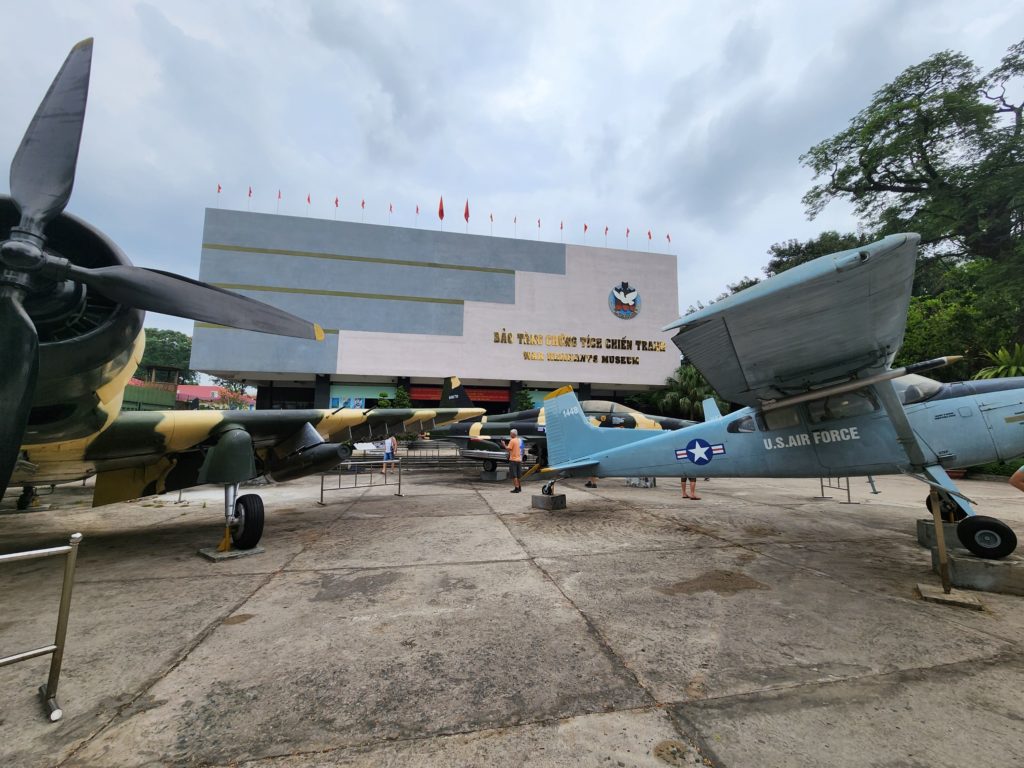
The War Remnants Museum, which shares details on the American/Vietnam War, is one of the top places to visit in Ho Chi Minh City. It was also one of the best museums I’ve personally visited in the world.
Enlarged posters promoting peace and unity cover the gate surrounding the museum. It is a bit of contrast to what it’s like entering the gates. In front of the entrance are US airplanes and tanks, and unexploded ordinances.
I learned a little bit about it in school, but it honestly wasn’t a huge part of my education in the US school system. In Hanoi, I learned a bit more about the war in the Ho Chi Minh Museum and the Hoa Lo War Relic. Still, the War Remnants Museum in Ho Chi Minh City was the most comprehensive overview of the war I’d seen.
The museum has three floors of exhibits. I recommend following the exhibits in the order according to the map.
The first exhibit gives more in-depth history behind the war
It details how it started, and how the US and other countries became so involved. Exhibits on this floor also discuss details of different key battles throughout the war and showcase works and tales of photojournalists who covered the war. These exhibits discuss how the Vietnam War was a major opportunity for photojournalism and how many died trying to cover it.
The ground floor has exhibits that cover the involvement of all the countries in the war. It also showcases the protests that happened on six continents against the war, illustrating its major global cultural impact. This floor also had reconstructed “Tiger Cages” where they held war prisoners.
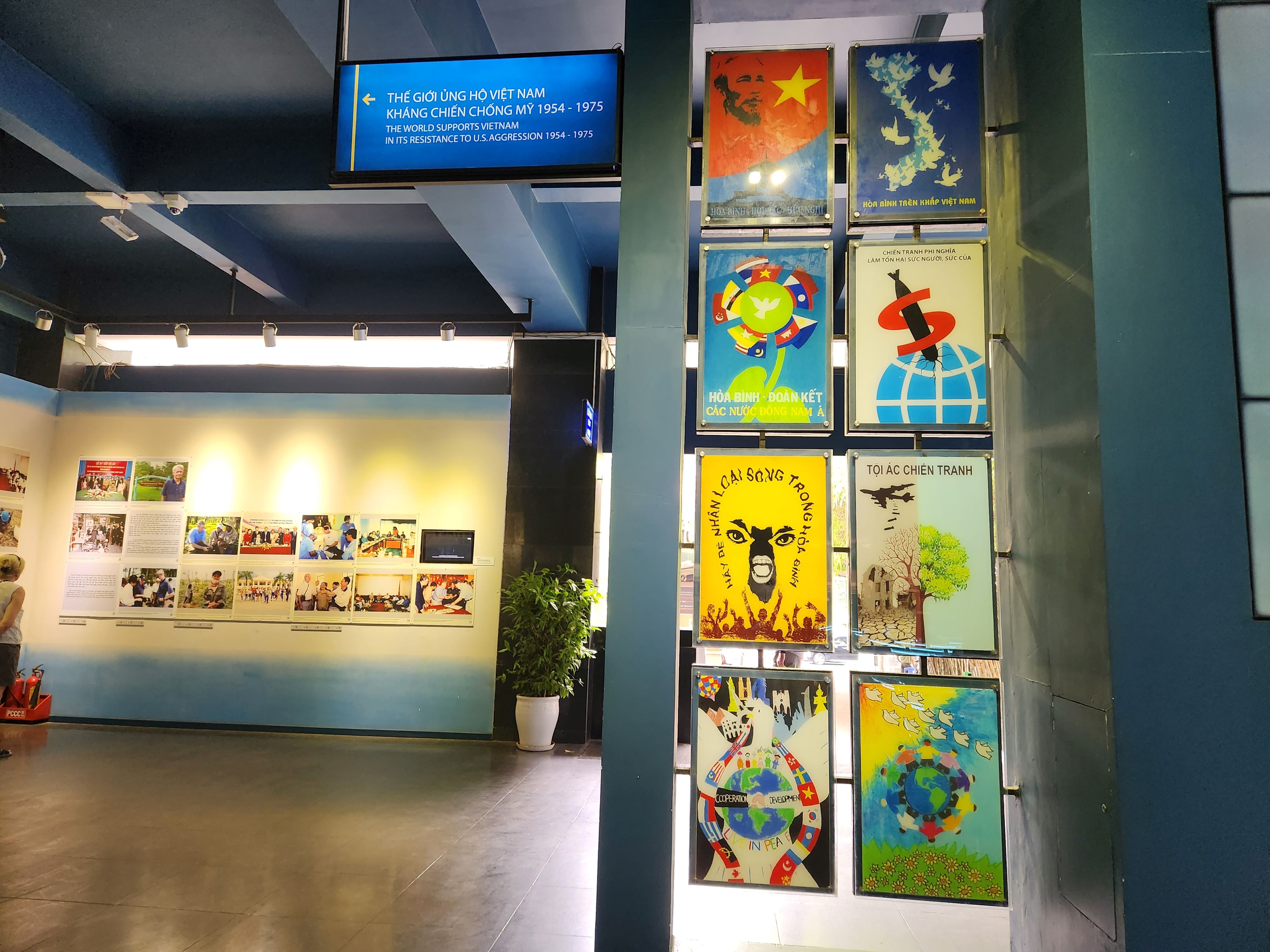
The most impactful exhibit was about Agent Orange
Agent Orange is the nickname for the chemical that the US sprayed in Vietnam during the war. The chemical was so toxic to all living things that it killed plants and animals in the forests and poisoned the waters and soil. It also caused death, serious injury and permanent disfigurement to people exposed to it. Effects of Agent Orange can also alter DNA and has been passed down across generations both of the Vietnamese and US soldiers exposed to it. There are babies born even today still experiencing the effects.
This exhibit was very difficult to go through. It explained the effects of Agent Orange and the reasons behind its use. It also had pictures and stories of those exposed to the chemical and suffered its effects throughout their lives. By the end, I was holding back tears. After this exhibit, we had to sit on a bench for a while and digest what we had just seen.
Visiting this museum was one of the first things we did in Ho Chi Minh City, and I’m glad that we did. It helped us appreciate other activities more with a foundation of knowledge we wouldn’t have otherwise had, particularly our trip to the Củ Chi Tunnels and tour of the Independence Palace.
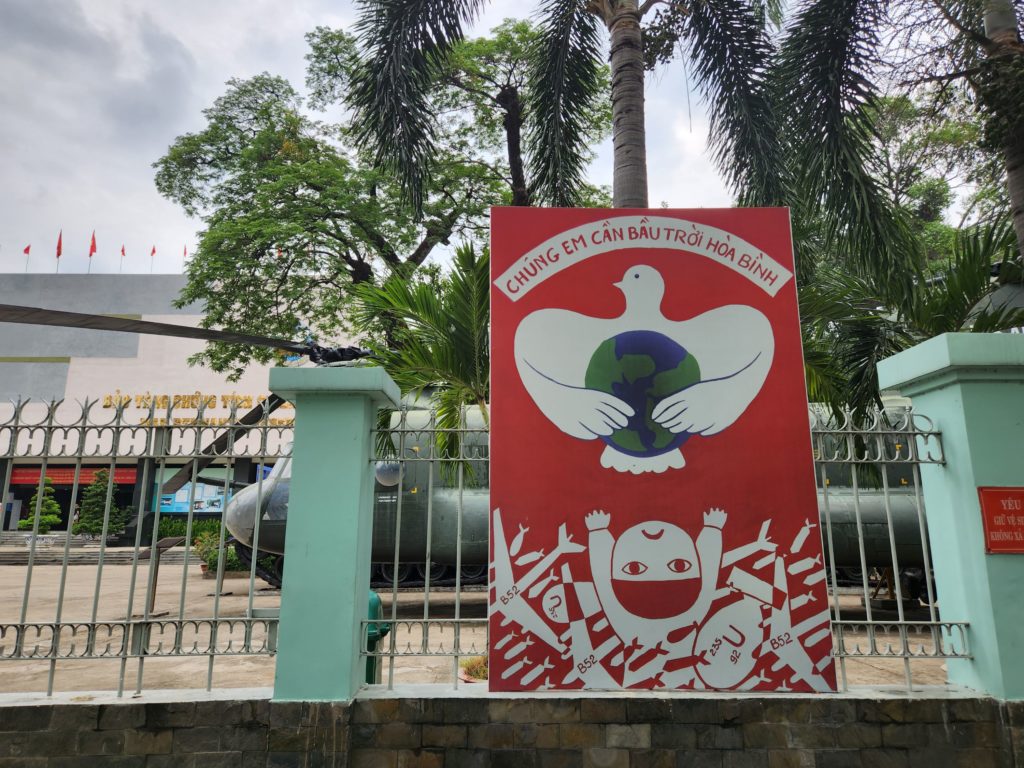
Scam Note:
We read about one “scam” before heading to the museum. There are men carrying small coconuts within a few blocks of the museum. They target tourists in this area and offer to direct you to it, then try to put a coconut in their hands and demand more money than the coconut is worth if accepted.
When we went to cross the street around the corner from the museum, a man with coconuts directed us across the street then gave us unsolicited directions to the museum. We already knew where we were going, but he was walking with and acting very friendly. He soon stopped walking with us and tried to hand me a coconut. I said no thank you, and he looked sort of offended, but we just kept walking. Maybe he was just truly trying to be friendly, but from what we’d read online, we thought he probably was not. We saw a few other men carrying small coconuts around the museum entrance as well.
Tour the Reunification Palace (aka Independence Palace)
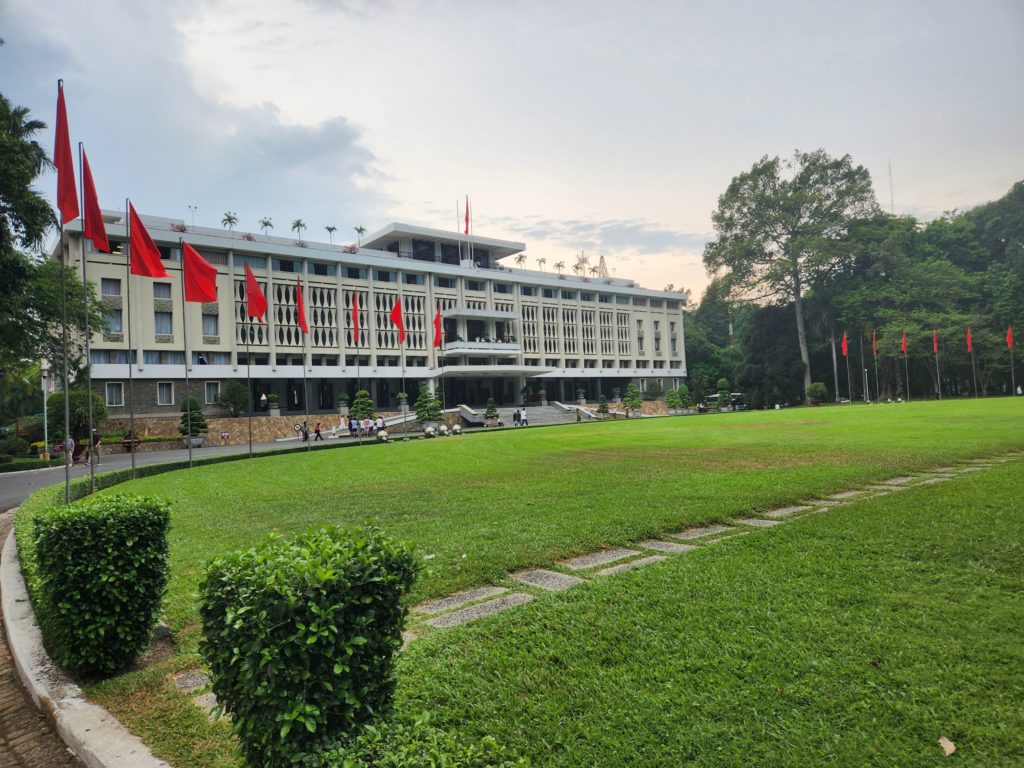
Near the War Remnants Museum is another popular tourist site in Ho Chi Minh City, the Reunification Palace. Also known as Independence Palace, this site is a designated historical relic of Vietnam. The Reunification Palace was the site of the end of the Vietnam War. It’s also where the president of what was South Vietnam lived and hosted world leaders.
While the palace itself is architecturally impressive, the coolest thing to me was how they had preserved the rooms from this era. You can walk through the entire palace and see the rooms frozen in the 1970s.
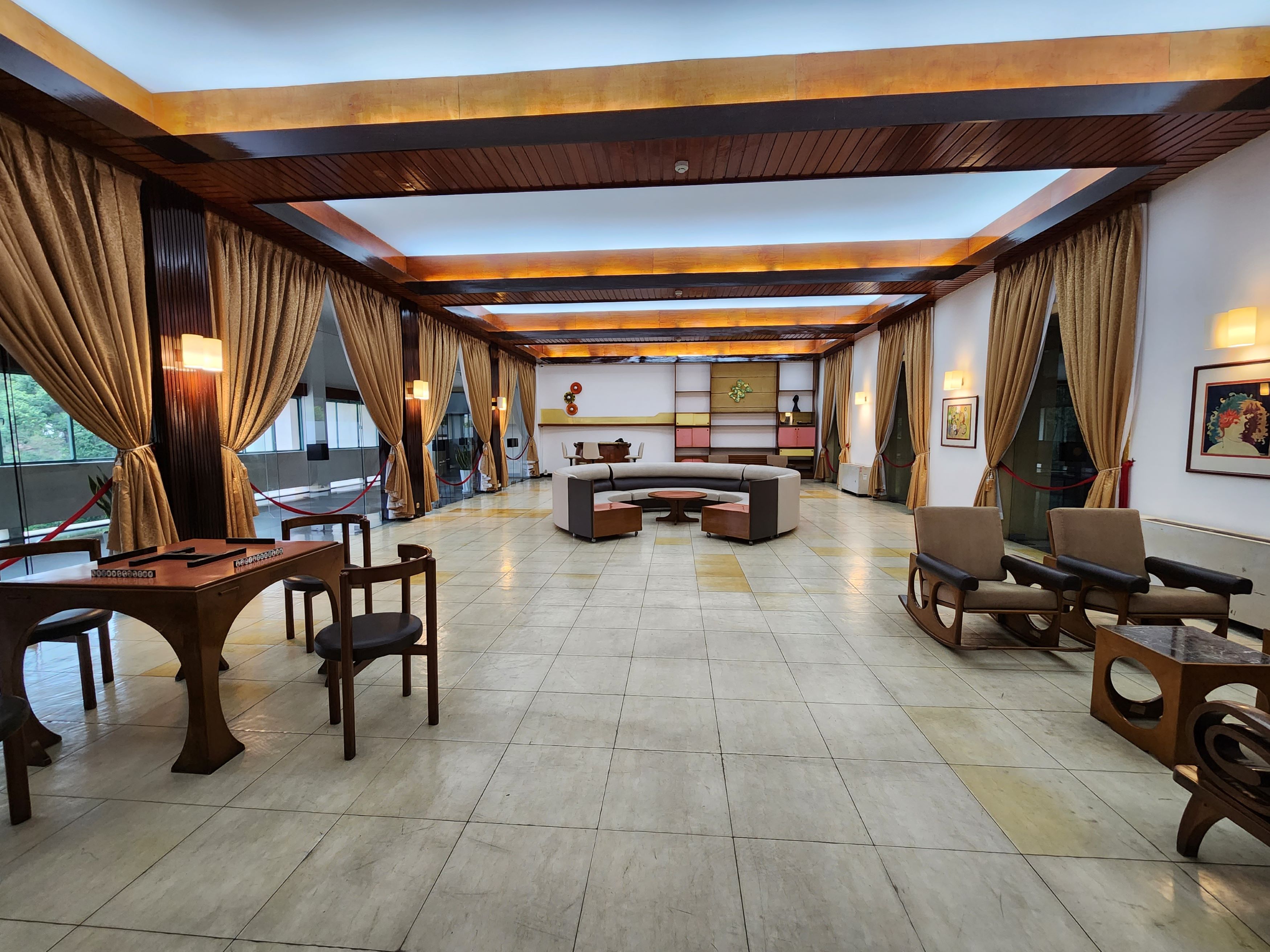
The top and bottom floors had the most interesting parts of the palace. The top floor was the party room. It held a dance floor and a piano, normal things you’d expect in a party room. But then right outside was a helicopter landing pad and helicopter. Two circles on the roof pinpointed where bombs fell on the palace.
This exhibit gave me even more appreciation for the bottom floor of the palace, which held the bunker where the president and his family stayed in case of bombings. Here, you can see the war rooms lined with old maps showing the strategies of both sides of the war. Geography shifts so often, and I love looking at old maps that show off how it has changed over the years. There were also rooms filled with old communication technology, a movie theater and more.
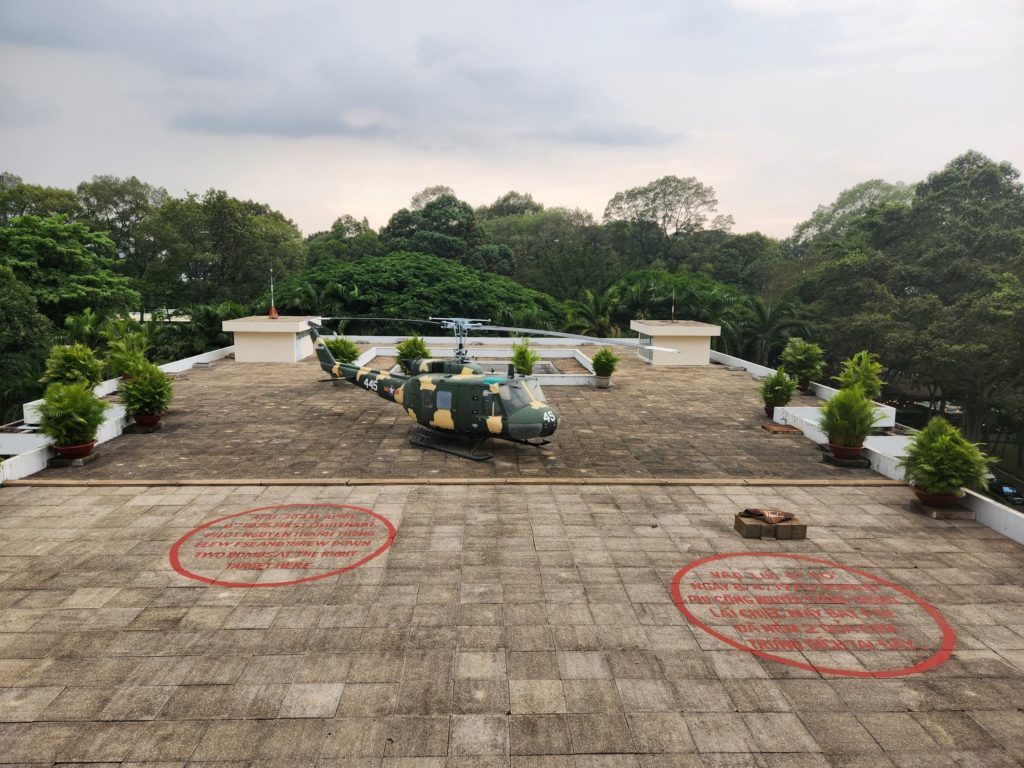
As you tour the Reunification Palace there are signs that explain different things about the building architecture, the decor and the use for the rooms. I was glad I’d gotten more context on it from the War Remnants Museum. I felt more able to appreciate its significance.
Haggle at Ben Thanh Market
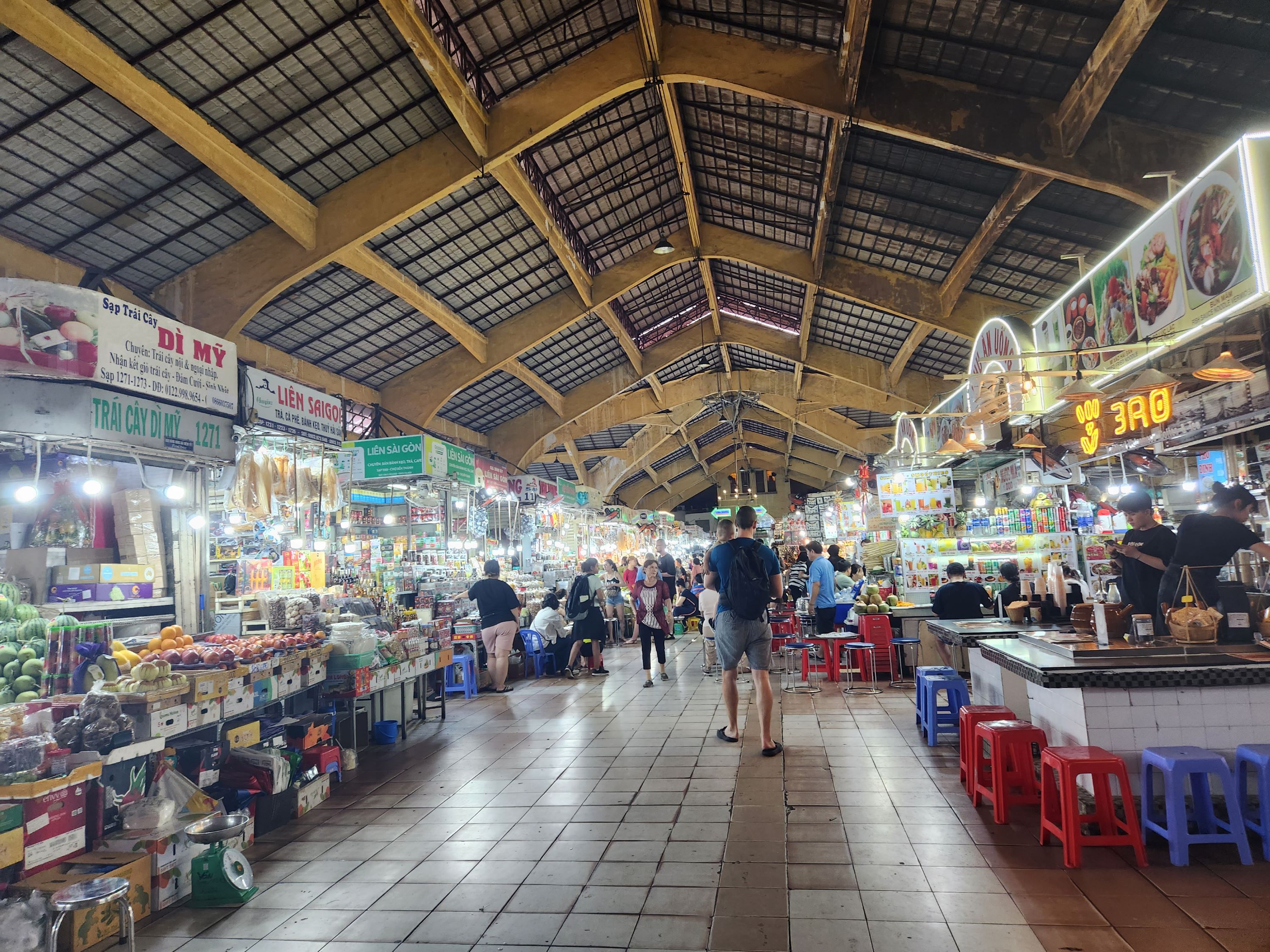
Ben Thanh Market is a giant covered market in the heart of District 1. It’s one of the largest and best-known markets in Ho Chi Minh City. From the outside, it doesn’t look like much. It’s much more impressive inside.
The market has stalls selling every kind of good or food you could want. As you walk through the produce section, you’ll catch a whiff of durian fruit. This market is one of the main places in Vietnam where you can buy the fruit pre-cut (I was told most Vietnamese buy the whole fruit). I wanted to buy some but could only find a big container of it. I knew I couldn’t take it to go even if I liked it. Our Airbnbs in Hanoi explicitly forbade durian in the rooms, so we didn’t want to chance taking it back to our room in HCMC. I regret this and plan to eat durian next time I travel to Southeast Asia. I think I’d like it.
There is a lot to buy at the market
Aside from produce, you can also purchase street food here or in the stalls outside the main entrances. There are also plenty of other goods like clothes, jewelry, watches and more. If you want to buy any of these, the most important thing to know is how to haggle. The rule in Vietnam is to start at about 10-30% of the price they first offer, then go up from there. If they won’t meet the price you want, then walk away, and they’ll typically go lower. While haggling may seem rude to westerners, it’s expected in the markets and part of the culture. Some people claim it’s important to haggle as a tourist so that the prices don’t become too inflated for locals, but I’m not entirely sure if that’s true.
Ben Thanh Market is open during the day and begins to close down around 6 p.m. for dinner. It reopens around 8 as a night market, which I’ve read is more lively than the daytime market. However, I was only there during the day a little before closing time, so I can’t speak to the comparison.
There are four main entrances, but they were honestly a little hard to find. The area of District 1 surrounding the market is filled with warehouse-looking buildings and different shops and stalls that are not officially part of the market. I kept going inside of these places while trying to find it in the first place. But then again, directions are not my forte (to put it mildly), so you may have an easier time of it.
Once you find it, you’ll have a good time whether you just want to shop or observe. I personally enjoyed it more than the Hanoi weekend Night Market.
Half-day trip to the Củ Chi Tunnels
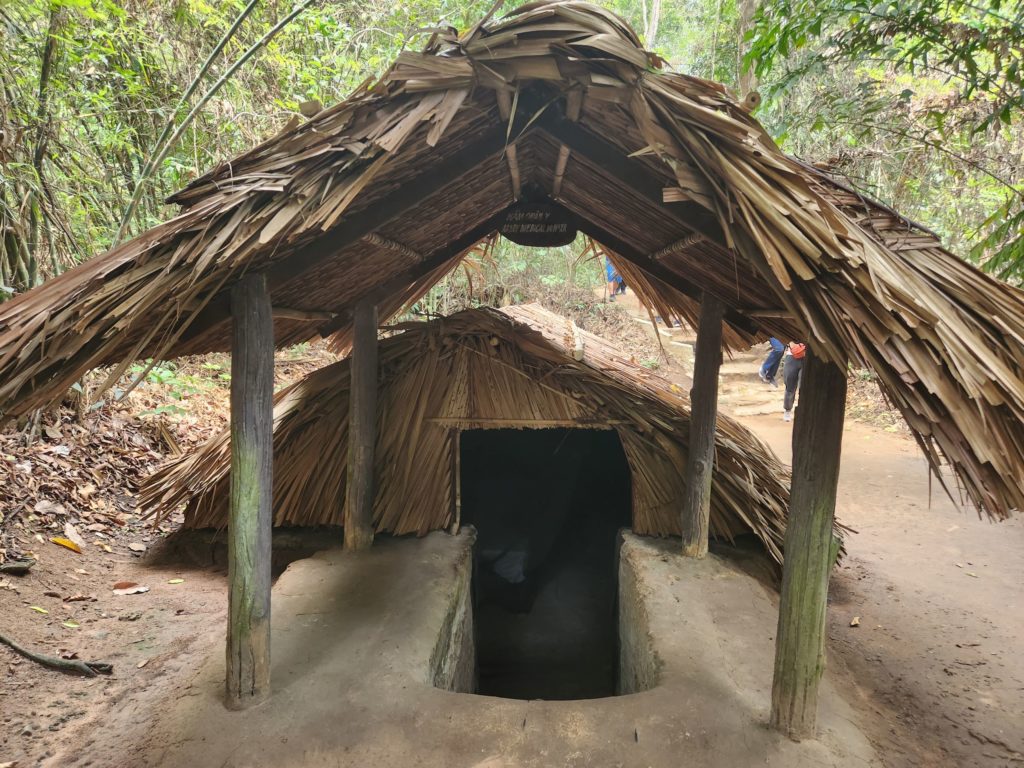
During the American/Vietnam War, the Vietnamese army established a vast and complex tunnel system throughout the country and parts of broader Indochina. To this day, I’m not sure if the full extent of the tunnel system has been completely uncovered. Soldiers used the tunnels to transport goods, weapons and, most importantly, information. They also used them to hide out from the American soldiers, build new weapons and strategize. Near these tunnels also often laid traps for the American soldiers.
In present day, you can visit the tunnels at Củ Chi to see them first-hand, along with the soldier traps and recreations of the workshops. You’ll also learn more about how the tunnels themselves.
I’ll go into more details in another post about our visit to the tunnels, but the highlight of our tour was getting to experience a little bit of what it was like inside of them. We crawled through a 100-meter long tunnel. It was expanded to accommodate tourists but still pretty cramped.
There is also an opportunity to go down one of the tunnel trap door entrances. To do this, you lower yourself into a small hole in the ground and cover your head with the trap door. I could only bring myself to stay under the ground for a few moments in the pitch black. Then, you have to push yourself up out of the hole. The tunnel entrance is quite narrow, so most people in our group opted out of this experience.
Although we got some background on the tunnels during the tour, I was so glad we’d visited the War Remnants Museum the day before making this trip. I think it really enriched the experience.
Visit the Mekong River Delta and Vinh Tran Pagoda
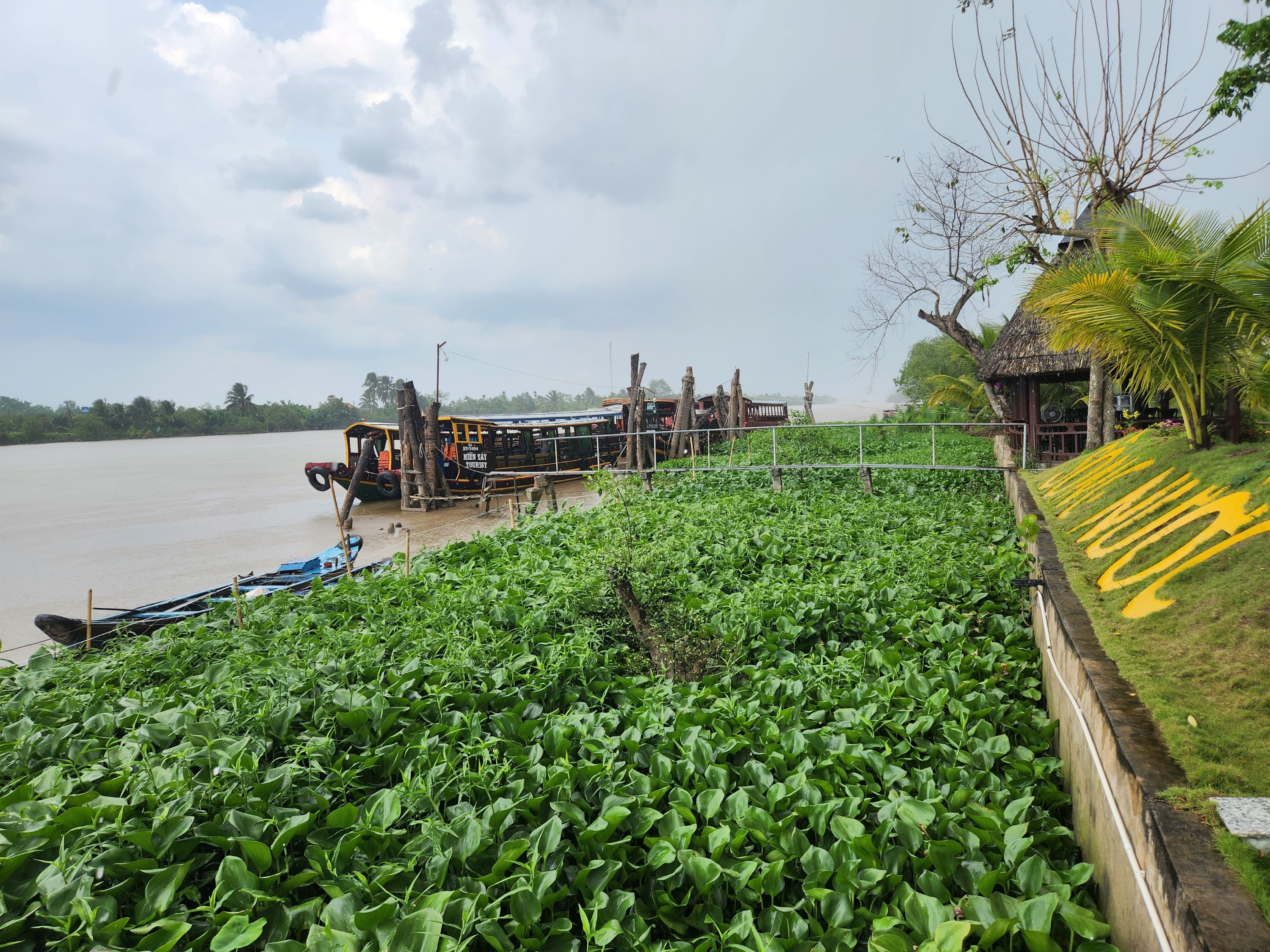
Another day trip you can do on its own or combined with the Củ Chi Tunnels is a trip to the Mekong River Delta. The Mekong River is about a two-hour drive from Ho Chi Minh City, and you can also book a tour through the usual sites like Viator, Get Your Guide and Airbnb Experiences. We combined our trip to the Mekong Delta with the Củ Chi Tunnels tour.
While I was glad I saw the Mekong Delta due to the economic, historical and cultural significance of the Mekong River, it honestly was not my favorite part of the trip. The trip out to the Delta felt more rushed and touristy than most anything else we’d done in Vietnam. I typically enjoy touristy things because – let’s face it – I’m a tourist. But it felt touristy in the sense that everyone was putting on a show and constantly trying to sell things to us.
I’ll go more into this full-day tour in my next post.
On the way back to Ho Chi Minh City, we made a brief stop at the Vinh Tran Pagoda to view the giant Buddha statues and beautiful temples. Most people did not want to get out to look at it due to the late-afternoon rain, though.
Experience the Jade Emperor Pagoda
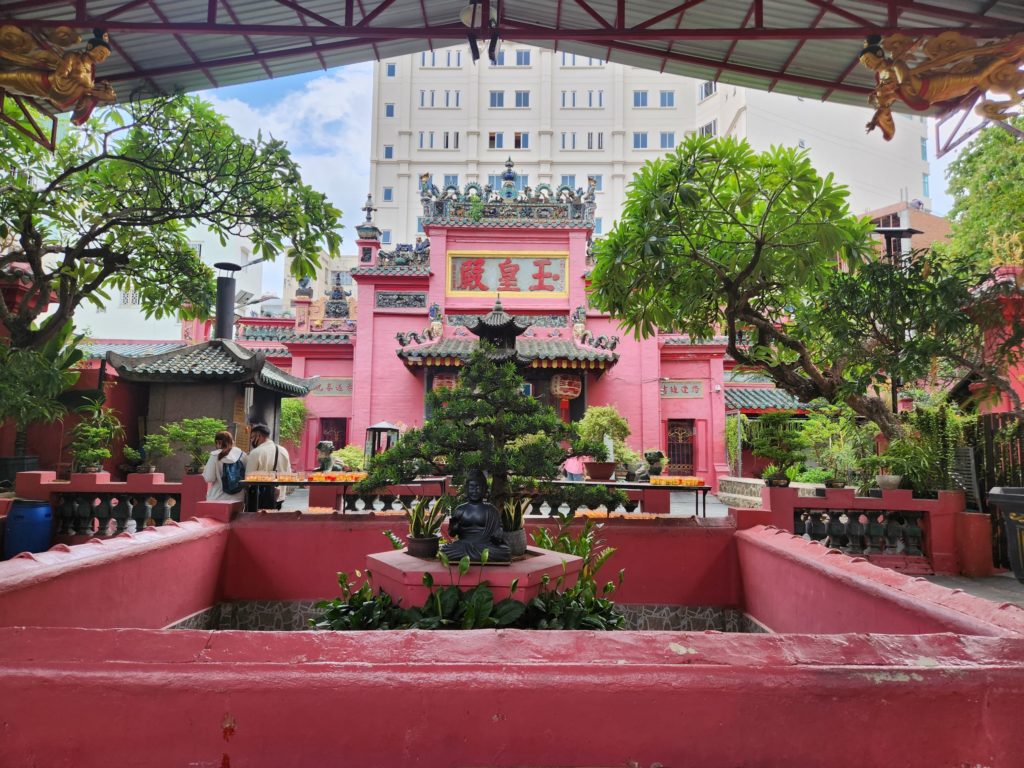
The Jade Emperor Pagoda (or Chùa Ngọc Hoàng in Vietnamese) is a Taoist temple built for the Jade Emperor, also known as the King of Heaven. It is located in District 1 and should not be confused with the Jade Palace Restaurant. Someone might have accidentally put that into their Google Maps.
Even if you input the right name, though, it can still be hard to find because Google Maps initially took us to the wrong place. It ended up being across a very busy road from where the app said it was. We asked a nice security guard who pointed us in the right direction despite the language barrier.
The Pagoda itself could be easy to miss when walking down the road. It’s smaller and more tucked away than I imagined. Also, despite being the Jade Emperor Pagoda, the temple itself is entirely pink. As you turn into the Pagoda, there are gardens with jade dragon statues protecting the temple.
The temple is free to enter, but there are offering boxes throughout where you can give a donation. As you enter the temple, there is also an area where you can buy a variety of things like apples and chocolate cream pie cookies to give as offerings to the gods.
The temple is a very holy place
There’s no photography or shoes allowed inside. There is a large main room with idols, then a few smaller rooms with idols and offering boxes. I’m not Taoist, so I just tried to respectfully take in the surroundings of the temple and observe. People would walk into the temple, purchase food for an offering, then take it to the gods to pray and bow. In the main room, there were people mopping constantly after people bowed in front of the threshold to keep the floors clean.
The temple didn’t technically have a dress code, but it is good manners to cover knees and shoulders before entering. In 2023 when we visited, they also required facemasks even in the garden area. If you don’t have a mask, they will provide one for free at the temple. There’s also a shop across the street that sells masks just in case.
Stroll by the Saigon River
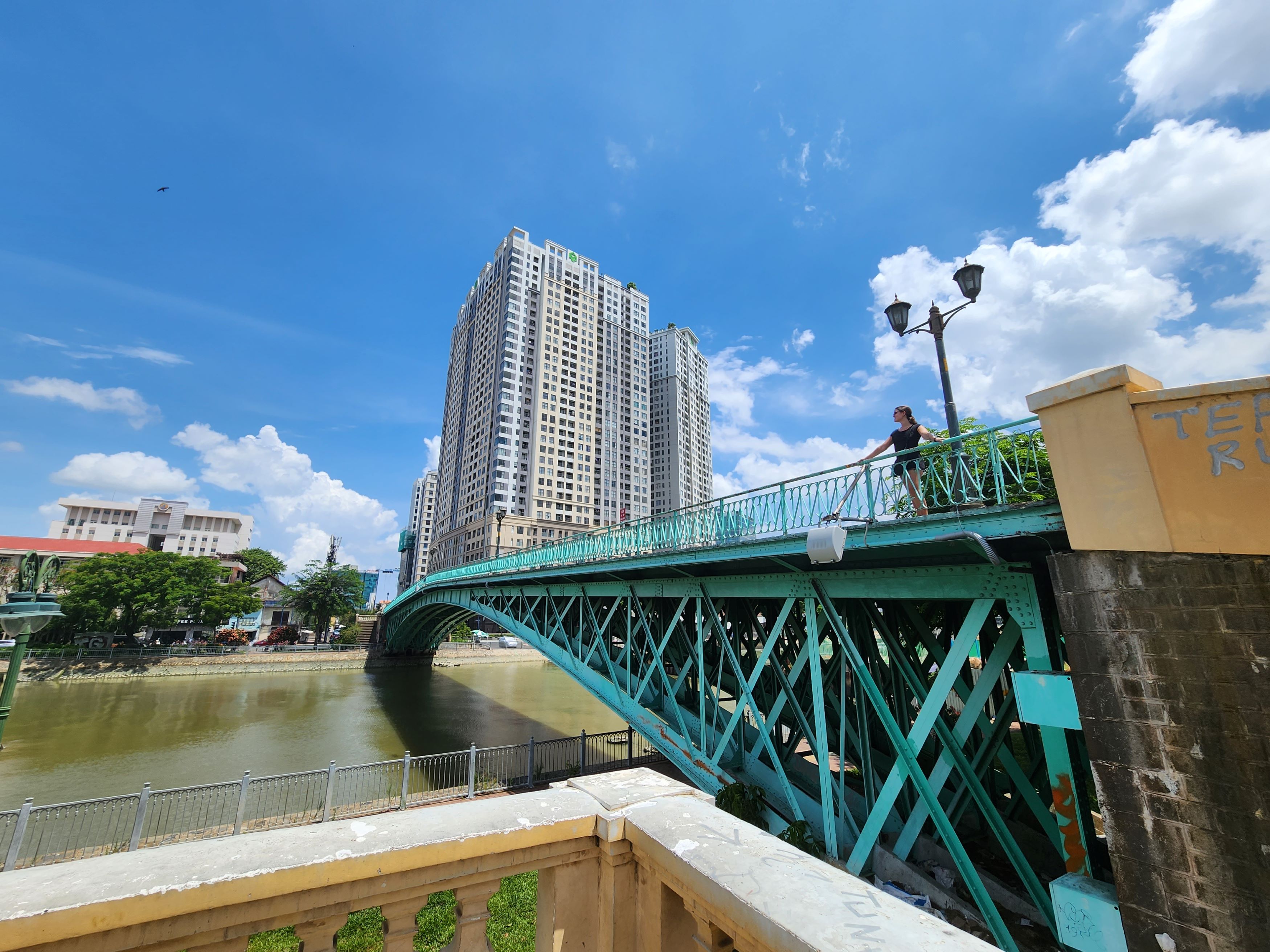
The Saigon River originates in Cambodia and flows through Ho Chi Minh City. It is a wide river that borders many neighborhoods in the city, including District 1. You can even take a water taxi to get to/from District 1 from/to other parts of the city.
If you want to experience the river from the water without a water taxi, there are companies that sell sunset/dinner cruises. However, we just decided to walk along the river from District 1 to District 3. It was worth it to see the neat bridges and beautiful flowers planted alongside the river.
We also took food there for a picnic, but there weren’t really any picnic tables next to the river like we thought we’d find. However, there are stool-type things to sit on and eat or just rest if you wanted to hang out by the water. It also has nice city views to admire as you stroll or sit next to it.
Mail a postcard at the Saigon Post Office
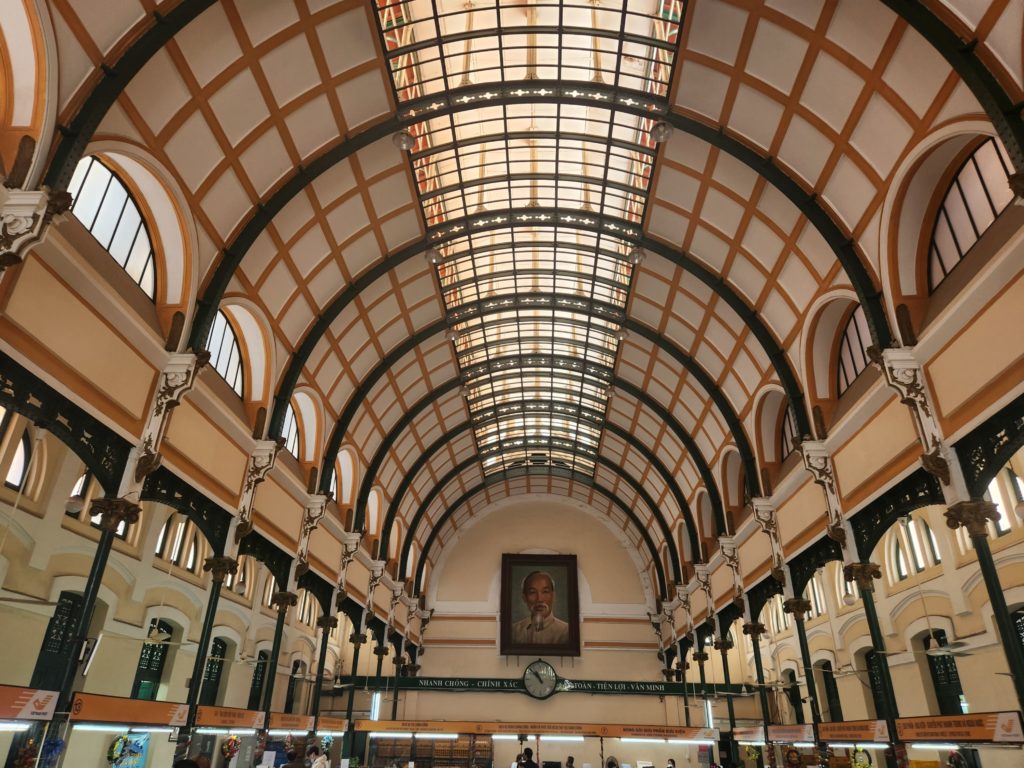
When I asked for recommendations of things to do in Ho Chi Minh City on Instagram, one of the main recommendations was to visit the post office. They promised it was worth seeing. And it was the most impressive post office I’d seen, aside from the one in Mexico City’s Centro Historico.
The Saigon Central Post Office was constructed in the 19th century, so the architecture has both French and Asian influences. Its gothic exterior and ornate interior decor, complete with a giant portrait of President Ho Chi Minh is gorgeous and definitely worth seeing.
Inside the post office, there is a small souvenir shop where you can purchase a postcard or trinket to mail if you want the full post office experience.
See the Notre Dame Cathedral of Saigon
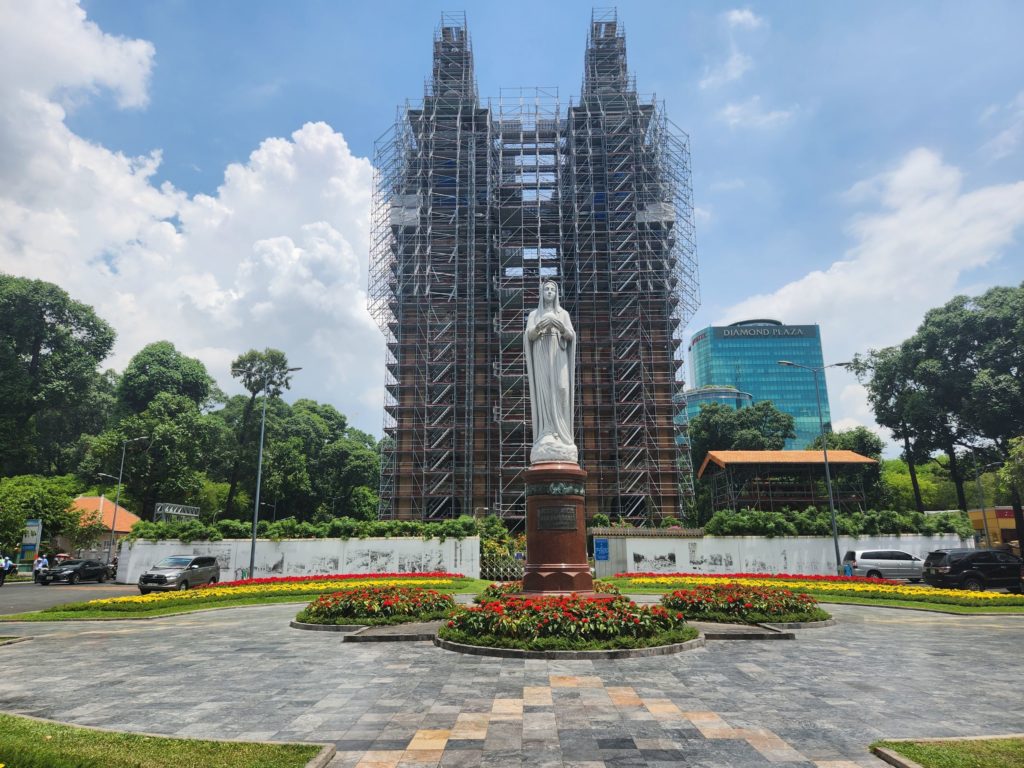
Across the street from the Post Office is the Notre Dame Cathedral of Saigon. French colonists established it in the 19th century, and it’s one of the oldest churches in the city.
In theory, you can buy tickets to go inside the church. However, it was under construction when we visited Ho Chi Minh City in May 2023. We did get to see the exterior of it, which looked much like other Catholic churches around the world.
Read on Book Street
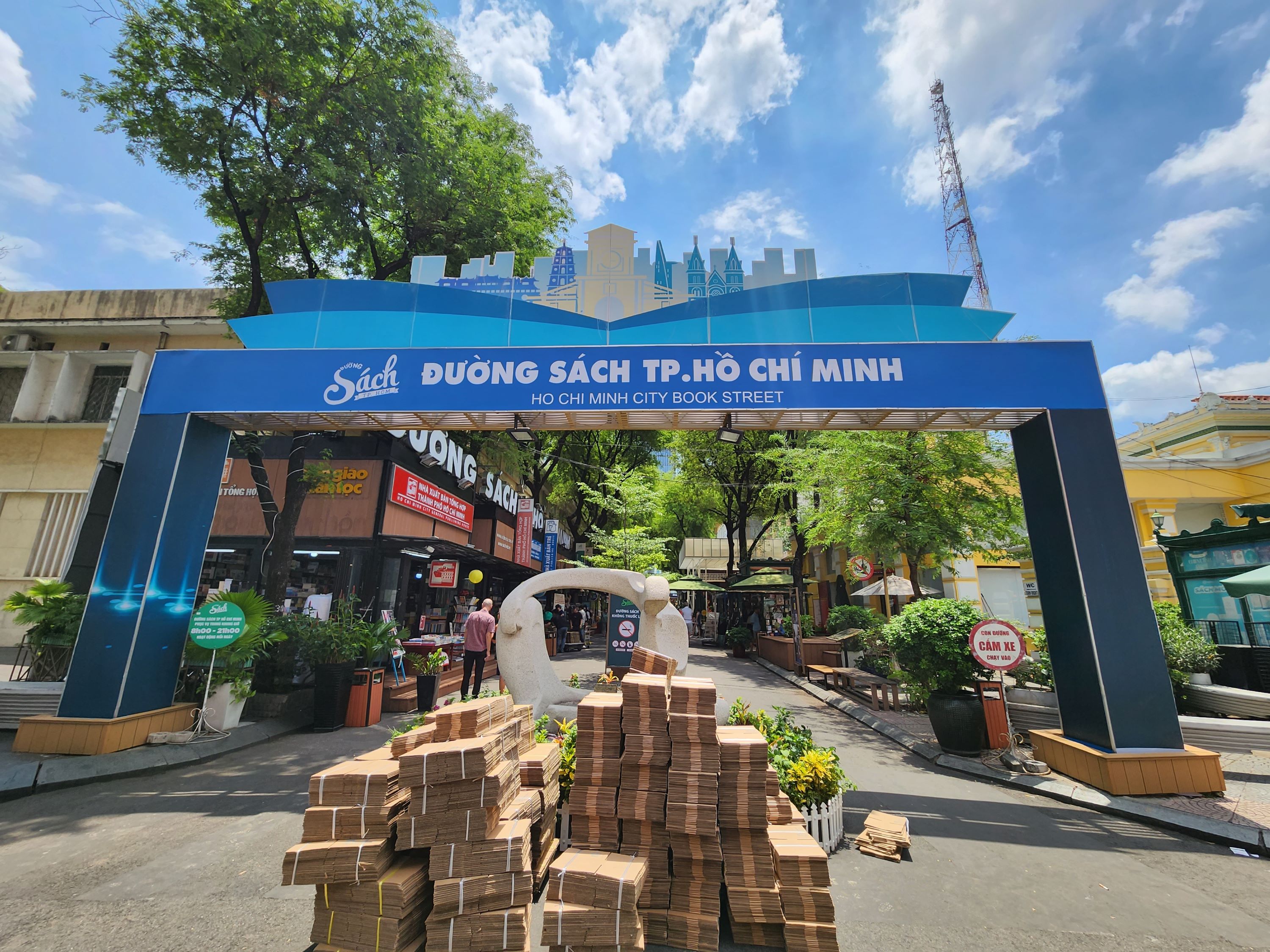
A couple of streets over from the Saigon Central Post Office and the Notre Dame Cathedral is the Ho Chi Minh City Book Street. This street is one of the oldest in the city. Book stores, arts and crafts shops and cafes line it. The book stores come in different shapes, sizes and genres. For example, there was a bookstore shaped like a small train.
We spent some time on the street browsing book selections in different genres and languages and even bought a couple of small souvenirs.
Try southern-style pho (and other dishes)
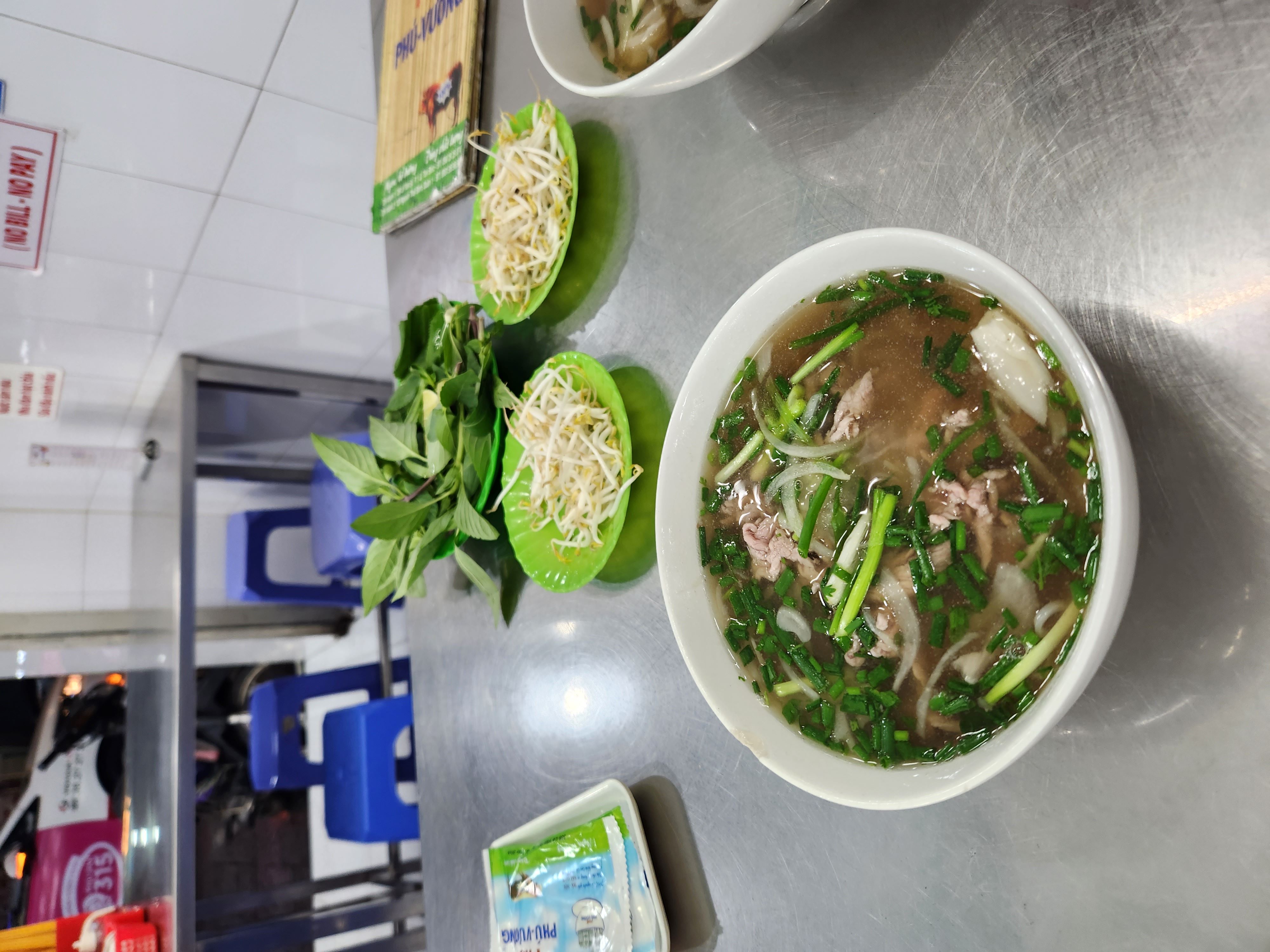
Pho is one of the best-known foods in Vietnam – at least to Americans. However, many people don’t realize there are different variations depending on the region. In the northern region of Vietnam, pho tends to be lighter and is flavored mainly with scallions. Chicken pho (pho ga) is more of the norm up north, from our understanding.
Southern style pho tends to be a spicier broth and usually contains more peppers, herbs, lime and bean sprouts. Beef pho (pho bo) is more of the norm here.
Southern style pho, and Southern style Vietnamese food in general, is more of what I was expecting when I visited the country. Many people who emigrated from Vietnam to the US were from the southern region. So flavors from this region were more familiar.
What we learned was that southern food tends to be spicier and includes more rice compared to the north, which incorporates more noodles. The biggest difference in food I personally observed was the spice and herbs.
Eat at the Ben Nghe Street Food Market
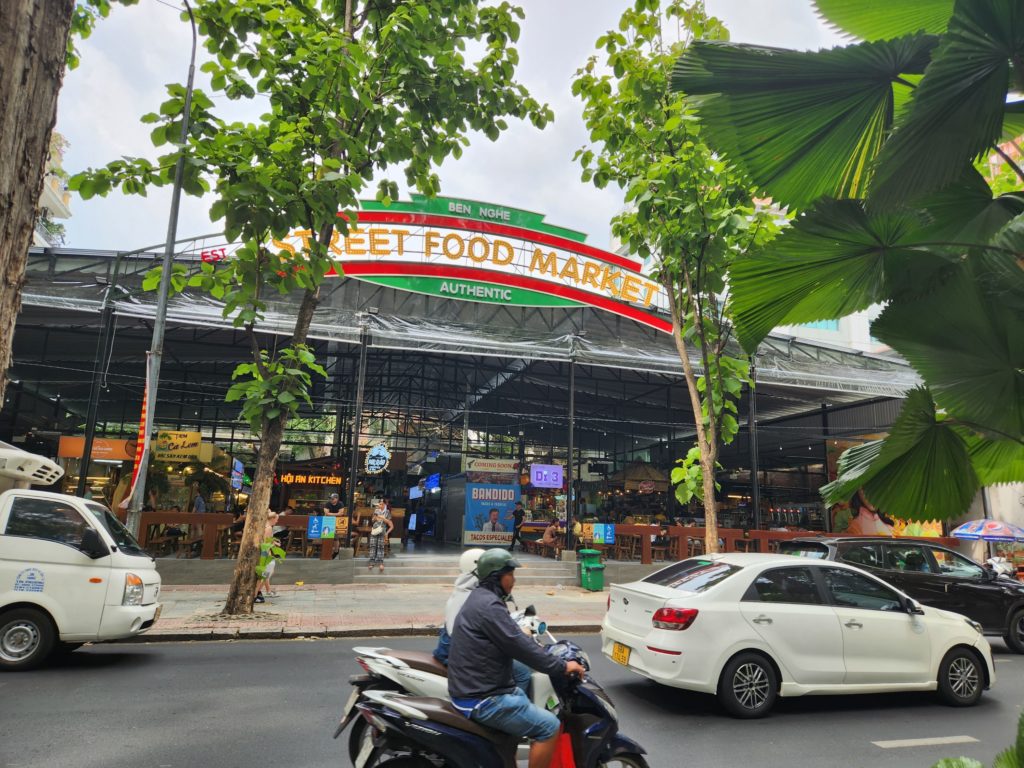
The Ben Nghe Street Food Market used to be inside of Ben Thanh market, but now is a separate food court near the Independence Palace. It hosts about a dozen or so Vietnamese and pan asian food and drink stalls.
It’s definitely more of a tourist attraction, and people complain that it lost its authenticity when it moved to a separate food court. As we approached the street food market, I was a little apprehensive about trying it. The most touristy place we’d eaten up until that point was at Banh Mi 25 in Hanoi, which proved to be a disappointment. However, this place had so many options, that it seemed worthwhile to give it a try.
We chose several Vietnamese and other Asian dishes located throughout the hall. The first were Banh Xeo – seafood pancakes – and com ta, which translates to “broken rice.” I’d read these dishes were must-haves in the south. We also ended up getting some dim sum and then mango sticky rice for dessert.
It turns out my fears were unfounded. I actually really liked the food! It was more expensive than anything else we’d had in Vietnam, but still was the equivalent of ~$21 USD for four dishes and four beers split among two people.
We later stumbled upon another street food market that seemed much more authentic
School kids and office workers on their lunch breaks filled it. We of course had to eat there as well, so we got in line at a busy stall that only served one dish (so we wouldn’t have to worry about the language barrier in ordering) and each got what turned out to be a pretty good chicken noodle salad. I could not tell you where this was located if my life depended on it – it was just one of those things you kind of stumble upon while walking around a neighborhood. But just know you can try both the touristy and the more local street food stalls in Ho Chi Minh City.
Sip cocktails at a speakeasy
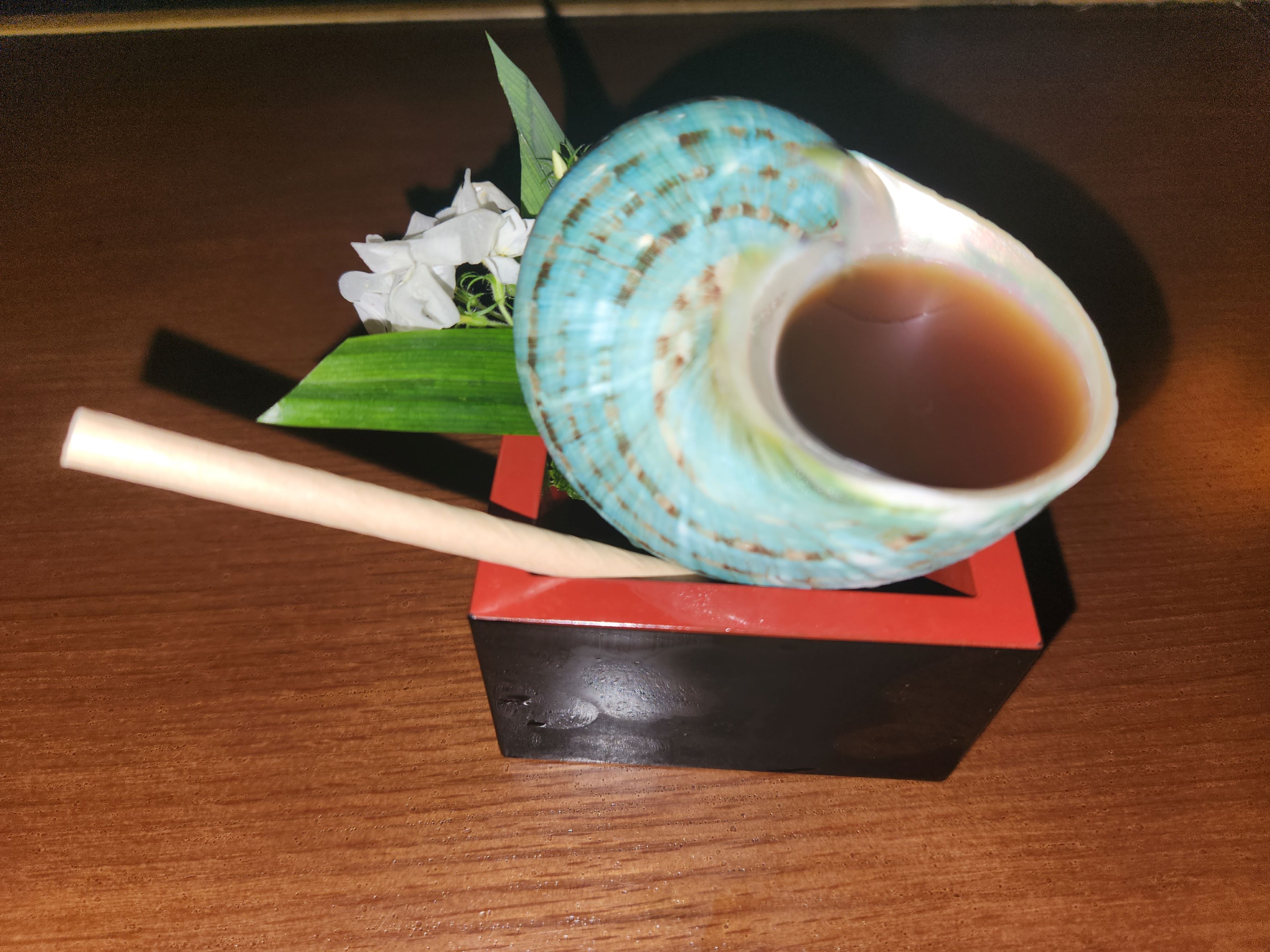
When we were in Hanoi, we met a university student who worked as a guide at the Ho Chi Minh Museum. He told us his favorite part of Vietnam was Ho Chi Minh City for the nightlife, which was something we hadn’t heard from any tourists.
We learned then that Ho Chi Minh City is known for its bars and particularly its speakeasies. There are speakeasies clustered mainly in Districts 1 (the main tourist neighborhood) and 3 (a big expat enclave). They have various themes, and each one we visited had delicious cocktails. One of the most interesting things to observe was the great care the bartenders would put into each cocktail.
Our favorite speakeasy was a place called Stir tucked away in a small area behind Ben Thanh Market. They serve both classic cocktails and cocktails with a Vietnamese twist. Some of them are served in interesting presentations, like a cocktail being completely doused in smoke. I got a cocktail served in a snail shell. As we were sipping our cocktails, we also noticed the wall of awards, one of which named Stir one of the best bars in Asia.
Check out Vietnam’s budding brewery scene
Though Vietnam’s bia hoi (beer corners) are well known for their cheap light beers, the country’s craft beer scene isn’t quite as popular yet. Craft breweries really only started popping up within the past decade. Luckily, many of the most popular Vietnamese breweries can be found in Ho Chi Minh City.
Because we only had three days in the city, we only really had time to check out one brewery. I think it was considered one of the best in the country/city. Heart of Darkness brewing had a variety of delicious beers. It had multiple options for both my partner, who tends to prefer light beers and pale ales, and for me, who tends to prefer darker beers. The beers were delicious and refreshing, especially after being out in the heat all day. The brewery decor was also very on-brand and evoked the eerie feeling of the novel by the same name.
Other popular craft breweries include Pasteur Street Brewing Company and East West Brewing.
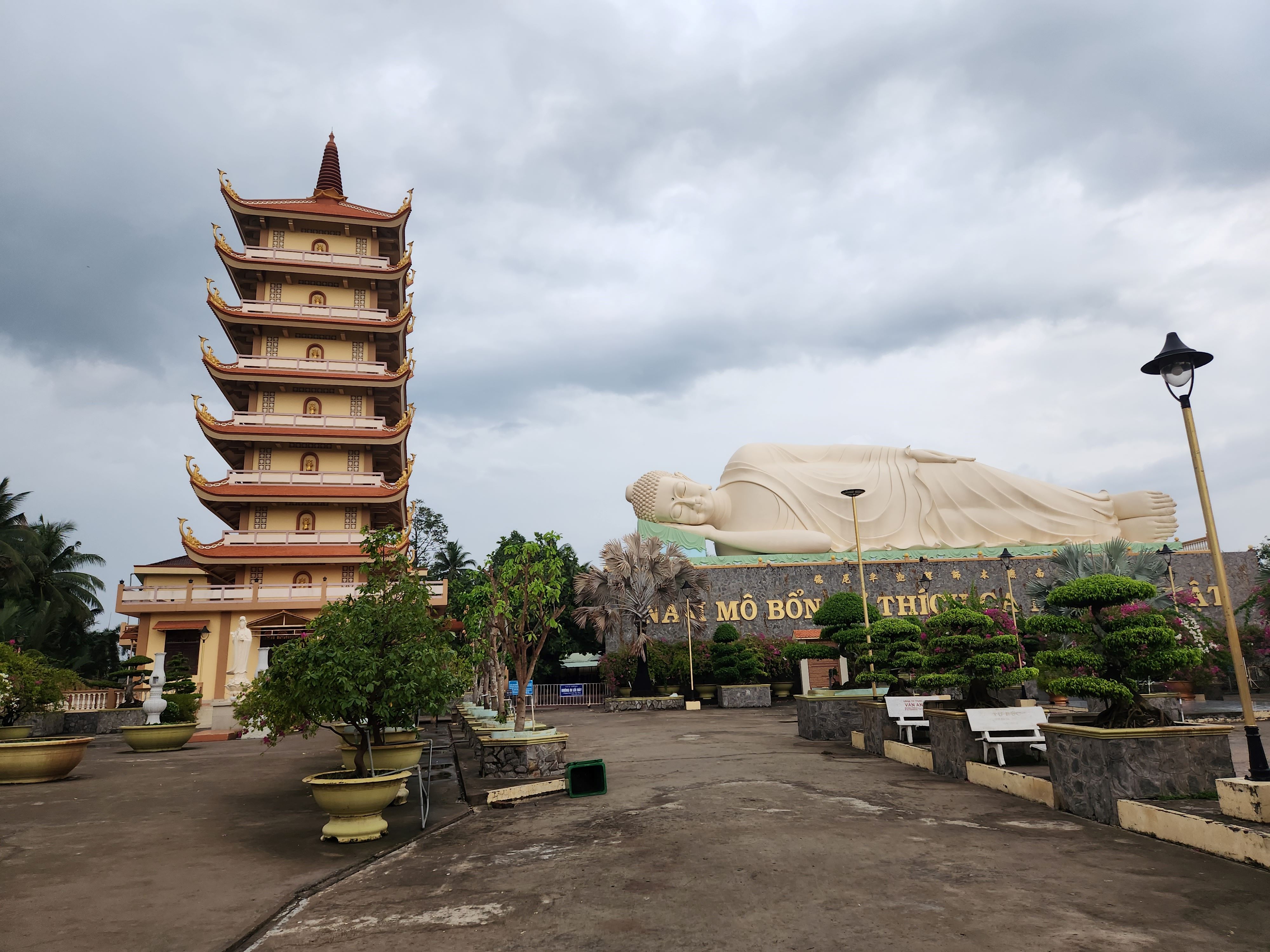
Logistics:
Where to Stay:
The two most popular neighborhoods to stay as a visitor to Ho Chi Minh City are District 1 (“Quan 1”) and District 3 (“Quan 3”).
District 1 is the best neighborhood to stay in if you only have a few days in the city. All the major attractions are in this neighborhood, including the major museums.
District 3 is a popular neighborhood for expats living in the city. It’s not too far from District 1, and accommodations are a little cheaper, so it can be a good option.
Safety:
Vietnam tends to be very safe as a whole. When we were in Hanoi, people told us Ho Chi Minh City was considered a little more dangerous in terms of pickpockets and phone snatchers. Apparently, there is more risk here of people riding by on a motorbike and snatching your phone out of your hand due to the busy streets here. However, we never had an issue.
Crossing the Street:
As in Hanoi, crossing the street here was a bit of an adventure. The streets in this city are wider and busier because it is Vietnam’s biggest city. However, there are more stoplights and crosswalk signs, and people seem to pay more attention to traffic laws here. There were even times when motorbikes waved me by, which never happened in Hanoi.
Is it Ho Chi Minh City or Saigon?
You might have noticed that there are times when the city or its attractions are referred to as “Ho Chi Minh City” and other times as “Saigon.” After the war, the name of the city was officially changed from Saigon to Ho Chi Minh City. If you ask anyone local to the region, they will tell you they call it Saigon. Meanwhile, up in Hanoi and outside of Vietnam, people call it by its official name of Ho Chi Minh City.
As a visitor to the country, I’d recommend referring to it as Ho Chi Minh City. However, it’s interesting to get different perspectives throughout the country.
Have you been to Ho Chi Minh City, or are you planning to go? Let me know!

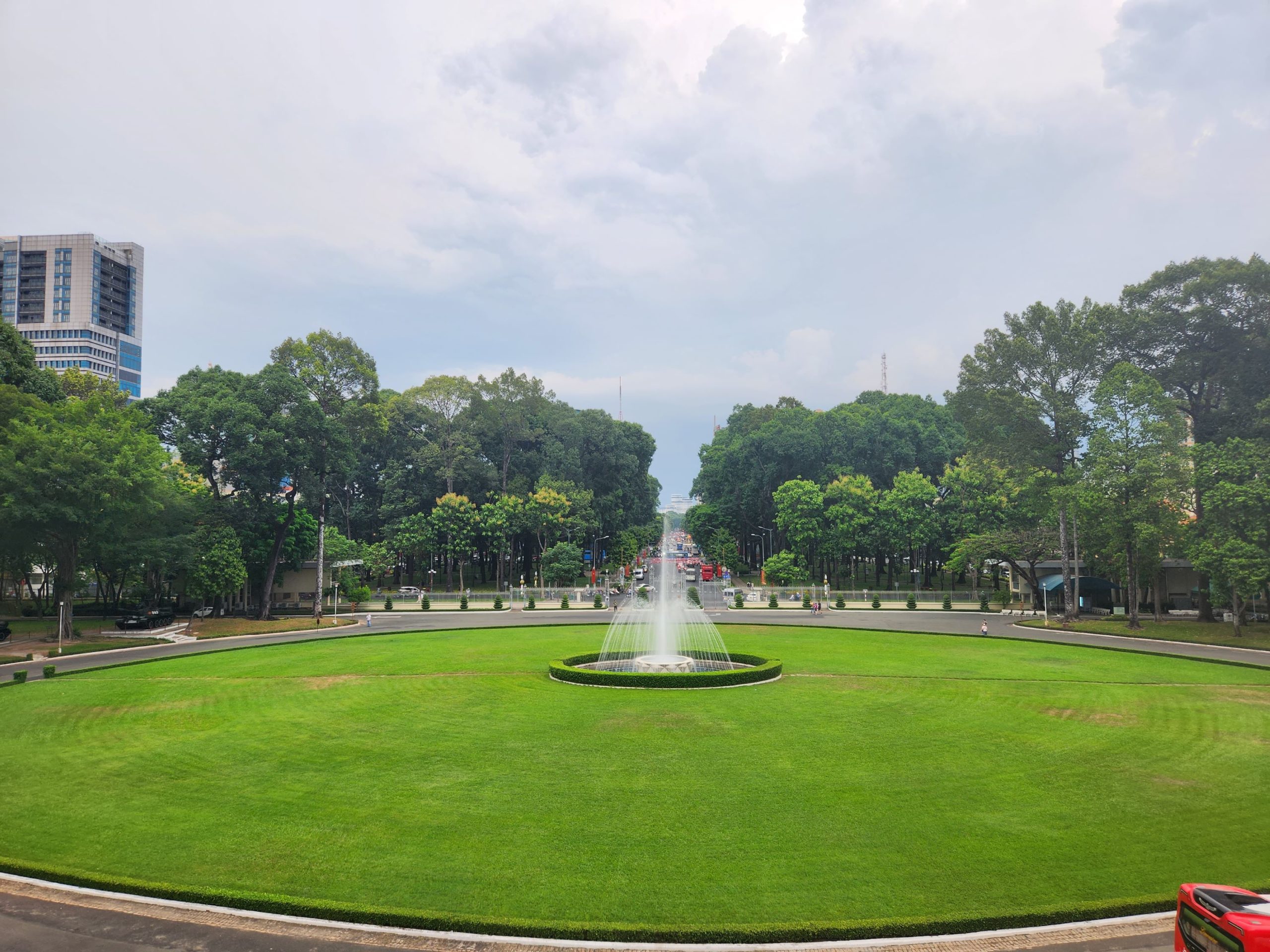
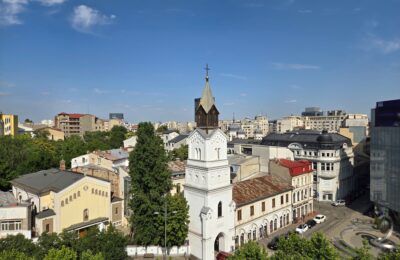
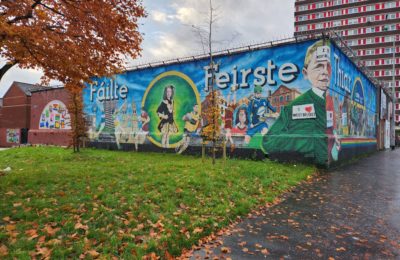
3 thoughts on “14 Amazing Things to do in Ho Chi Minh City, Vietnam”